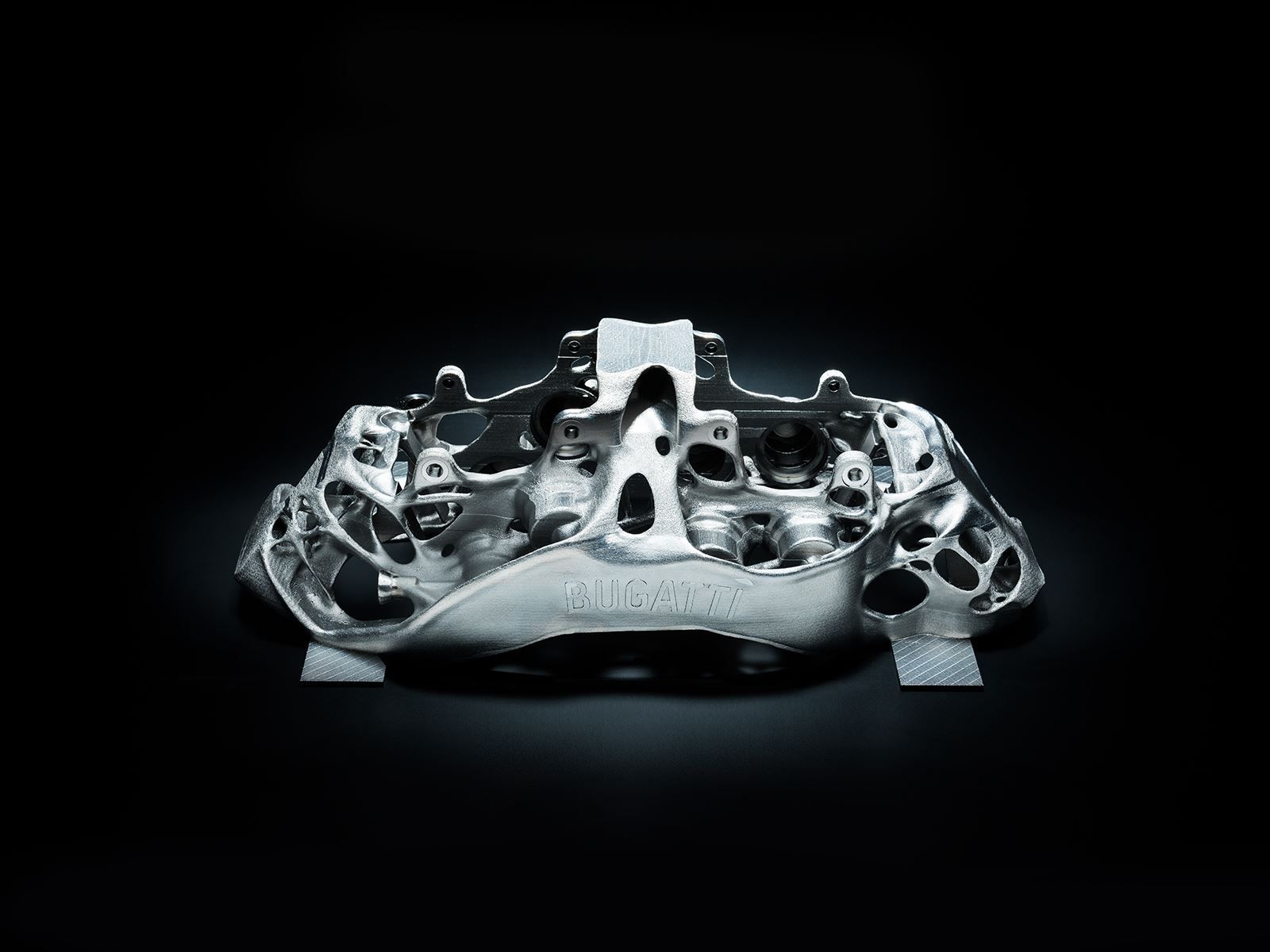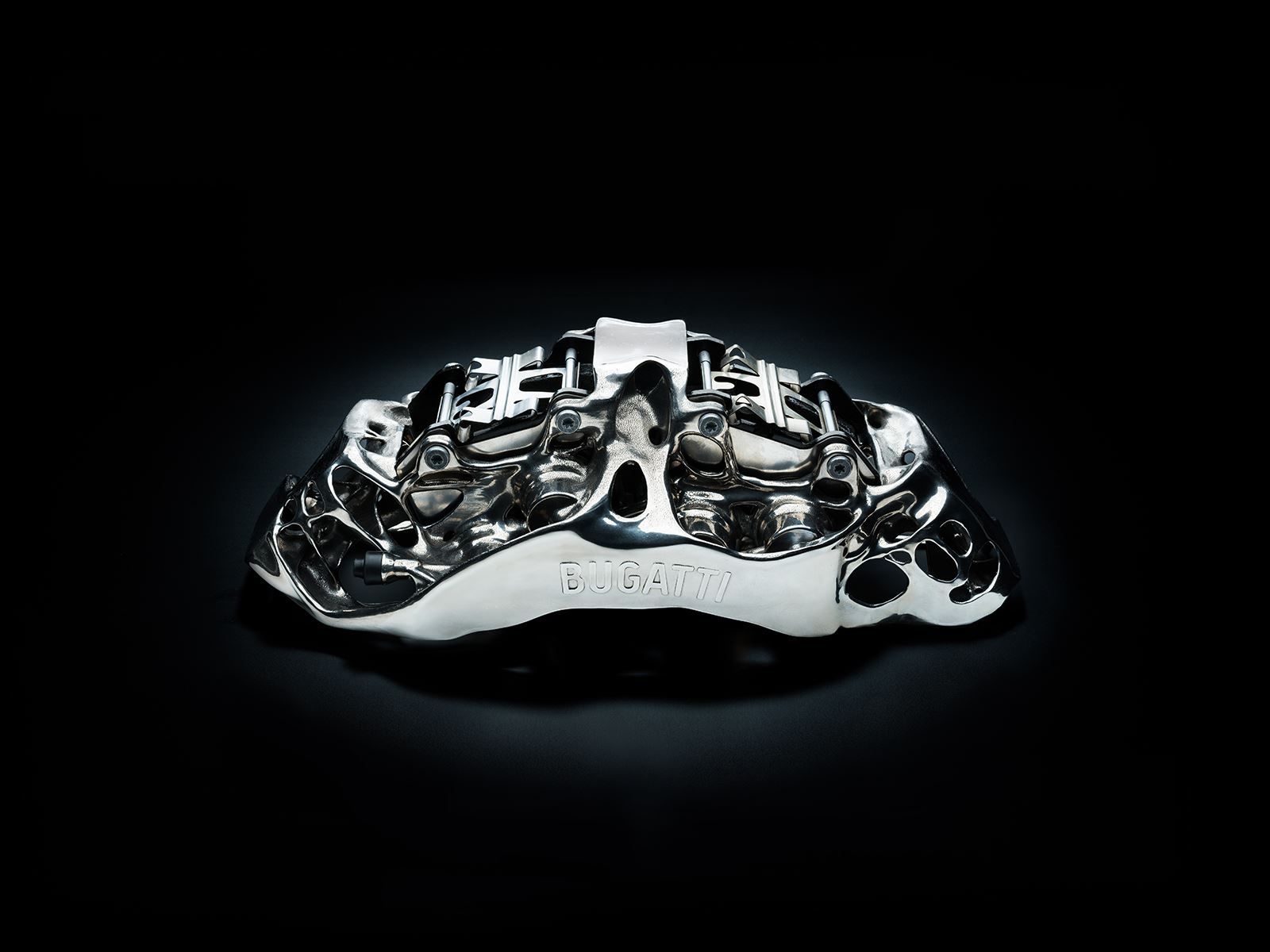
Bugatti is continually pushing the limits of supercar design and manufacturing innovation. The production process of the Chiron, for example, is insanely intricate, requiring nine months of manufacturing using 1,800 parts. And now the automaker has achieved a new milestone with the design and development of the world's first 3D-printed brake caliper. Most components are traditionally made from aluminium but Bugatti's new brake caliper is made from strong titanium, making it the world's largest functional component produced from titanium using 3D printing.
This new milestone in 3D printing development was achieved with the help of Laser Zentrum Nord of Hamburg, an institute that has formed part of the Fraunhofer research organization since earlier this year. "Vehicle development is a never-ending process. This is particularly true at Bugatti," says Bugatti's Head of New Technologies Frank Gotzke. "In our continuing development efforts, we are always considering how new materials and processes can be used to make our current model even better and how future vehicles of our brand could be designed. As our performance data are often at the physical limits, we are especially demanding."
"This is why Bugatti always goes at least one step further than other manufacturers in the development of technical solutions." Forged from a block of high-strength aluminium alloy, the Chiron currently has the most powerful brakes in the world developed exclusively for the model. Featuring eight titanium pistons on each of the front calipers and six on the rear units, they are also the largest brake calipers to ever be fitted to a production vehicle. Taking the technology a step further, the titanium alloy in Bugatti's newly developed 3D-printed brake caliper is mainly used in the aerospace industry for highly stressed undercarriage and wing components or in aircraft and rocket engines.
It offers considerably higher performance than aluminium, with strength that allows a force of slightly more than 125 kg to be applied to a square millimetre without the material rupturing. Measuring 41 cm long, 21 cm wide and 13.6 cm high, Bugatti's titanium brake caliper weighs just 2.9 kg in comparison to the current aluminium component which weighs 4.9 kg. Using this new part would therefore result in a weight reduction of 40 percent and better strength, despite being a 3D printed component. This process was previously not possible due to the difficulty of milling and forging components from a titanium block.
However, Bugatti solved this by using an extremely high-performance 3D printer and laser melting units at Laser Zentrum Nord in Hamburg, Germany. "Laser Zentrum Nord is one of many scientific institutes with which we have developed very good cooperation over the years," Gotzke explains. "Thanks to the large number of projects completed, mainly for the aviation industry, the institute has comprehensive know-how especially in the field of titanium processing and offers mature technology." Development of Bugatti's 3D-printed titanium brake caliper took around three months in total from the initial idea to the first printed component.
The basic concept, strength and stiffness simulations and calculations, and design drawings were sent to Laser Zentrum Nord by Bugatti. The institute then carried out the process simulation, the design of the supporting structures, actual printing and the treatment of the component. Bugatti was responsible for the finishing. Using the largest printer in the world equipped with four 400-watt lasers, printing the brake caliper took 45 hours. During the process, titanium powder is deposited layer by layer. The four lasers melt the titanium powder into the shape defined for the brake caliper before cooling immediately. 2,213 layers are required in total.
Heat treatment is then carried out in a furnace where the brake caliper is exposed to an initial temperature of 700°C, to eliminate residual stress and to ensure dimensional stability. Once the supporting structures are removed, the surface is then smoothed in a combined mechanical, physical and chemical process which drastically improves its long-term strength. Finally, the contours of functional surfaces, such as the piston contact surfaces or threads, are machined in a five-axis milling machine which takes another 11 hours to complete. The result is a "delicately shaped component" with wall thicknesses between a minimum of only one millimetre and a maximum of four millimetres.
"It was a very moving moment for the team when we held our first titanium brake caliper from the 3-D printer in our hands," Gotzke recalls. "In terms of volume, this is the largest functional component produced from titanium by additive manufacturing methods. Everyone who looks at the part is surprised at how light it is – despite its large size. Technically, this is an extremely impressive brake caliper, and it also looks great." According to Bugatti, vehicles using the 3D titanium brake caliper will be trailed in the first half of this year before starting series production. Bugatti's latest technical innovation should drastically reduce production times, especially for machining.








